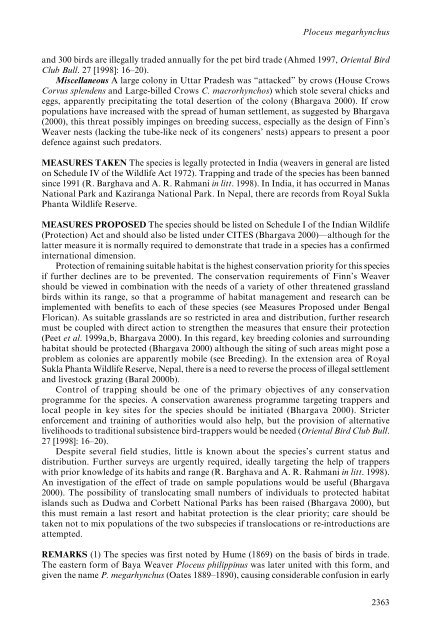Threatened Birds of Asia: - BirdLife International
Threatened Birds of Asia: - BirdLife International
Threatened Birds of Asia: - BirdLife International
Create successful ePaper yourself
Turn your PDF publications into a flip-book with our unique Google optimized e-Paper software.
Ploceus megarhynchus<br />
and 300 birds are illegally traded annually for the pet bird trade (Ahmed 1997, Oriental Bird<br />
Club Bull. 27 [1998]: 16–20).<br />
Miscellaneous A large colony in Uttar Pradesh was “attacked” by crows (House Crows<br />
Corvus splendens and Large-billed Crows C. macrorhynchos) which stole several chicks and<br />
eggs, apparently precipitating the total desertion <strong>of</strong> the colony (Bhargava 2000). If crow<br />
populations have increased with the spread <strong>of</strong> human settlement, as suggested by Bhargava<br />
(2000), this threat possibly impinges on breeding success, especially as the design <strong>of</strong> Finn’s<br />
Weaver nests (lacking the tube-like neck <strong>of</strong> its congeners’ nests) appears to present a poor<br />
defence against such predators.<br />
MEASURES TAKEN The species is legally protected in India (weavers in general are listed<br />
on Schedule IV <strong>of</strong> the Wildlife Act 1972). Trapping and trade <strong>of</strong> the species has been banned<br />
since 1991 (R. Barghava and A. R. Rahmani in litt. 1998). In India, it has occurred in Manas<br />
National Park and Kaziranga National Park. In Nepal, there are records from Royal Sukla<br />
Phanta Wildlife Reserve.<br />
MEASURES PROPOSED The species should be listed on Schedule I <strong>of</strong> the Indian Wildlife<br />
(Protection) Act and should also be listed under CITES (Bhargava 2000)—although for the<br />
latter measure it is normally required to demonstrate that trade in a species has a confirmed<br />
international dimension.<br />
Protection <strong>of</strong> remaining suitable habitat is the highest conservation priority for this species<br />
if further declines are to be prevented. The conservation requirements <strong>of</strong> Finn’s Weaver<br />
should be viewed in combination with the needs <strong>of</strong> a variety <strong>of</strong> other threatened grassland<br />
birds within its range, so that a programme <strong>of</strong> habitat management and research can be<br />
implemented with benefits to each <strong>of</strong> these species (see Measures Proposed under Bengal<br />
Florican). As suitable grasslands are so restricted in area and distribution, further research<br />
must be coupled with direct action to strengthen the measures that ensure their protection<br />
(Peet et al. 1999a,b, Bhargava 2000). In this regard, key breeding colonies and surrounding<br />
habitat should be protected (Bhargava 2000) although the siting <strong>of</strong> such areas might pose a<br />
problem as colonies are apparently mobile (see Breeding). In the extension area <strong>of</strong> Royal<br />
Sukla Phanta Wildlife Reserve, Nepal, there is a need to reverse the process <strong>of</strong> illegal settlement<br />
and livestock grazing (Baral 2000b).<br />
Control <strong>of</strong> trapping should be one <strong>of</strong> the primary objectives <strong>of</strong> any conservation<br />
programme for the species. A conservation awareness programme targeting trappers and<br />
local people in key sites for the species should be initiated (Bhargava 2000). Stricter<br />
enforcement and training <strong>of</strong> authorities would also help, but the provision <strong>of</strong> alternative<br />
livelihoods to traditional subsistence bird-trappers would be needed (Oriental Bird Club Bull.<br />
27 [1998]: 16–20).<br />
Despite several field studies, little is known about the species’s current status and<br />
distribution. Further surveys are urgently required, ideally targeting the help <strong>of</strong> trappers<br />
with prior knowledge <strong>of</strong> its habits and range (R. Barghava and A. R. Rahmani in litt. 1998).<br />
An investigation <strong>of</strong> the effect <strong>of</strong> trade on sample populations would be useful (Bhargava<br />
2000). The possibility <strong>of</strong> translocating small numbers <strong>of</strong> individuals to protected habitat<br />
islands such as Dudwa and Corbett National Parks has been raised (Bhargava 2000), but<br />
this must remain a last resort and habitat protection is the clear priority; care should be<br />
taken not to mix populations <strong>of</strong> the two subspecies if translocations or re-introductions are<br />
attempted.<br />
REMARKS (1) The species was first noted by Hume (1869) on the basis <strong>of</strong> birds in trade.<br />
The eastern form <strong>of</strong> Baya Weaver Ploceus philippinus was later united with this form, and<br />
given the name P. megarhynchus (Oates 1889–1890), causing considerable confusion in early<br />
2363
















